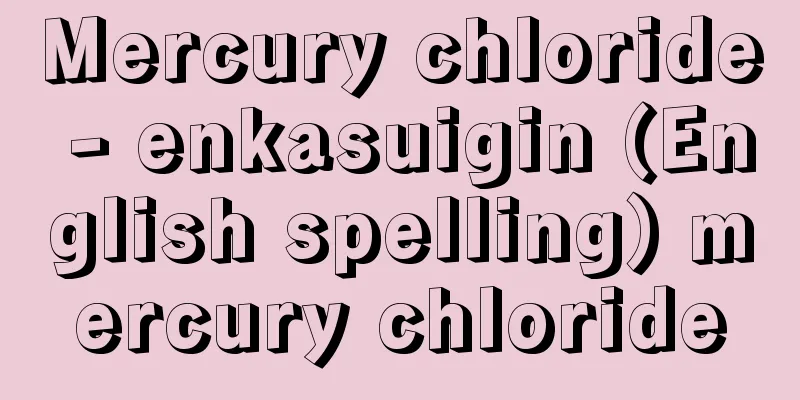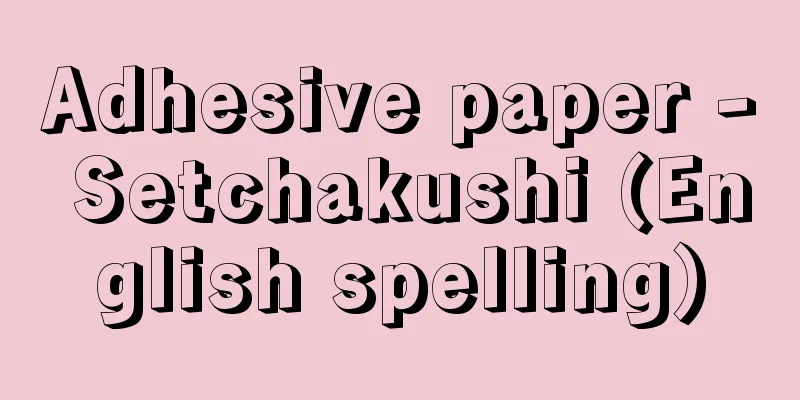Mercury chloride - enkasuigin (English spelling) mercury chloride

|
Compounds of mercury and chlorine. Both monovalent and divalent compounds are known. (1) Mercury(I) chloride (mercurous chloride) Commonly known as calomel or calomel. A colorless, shiny crystal obtained by adding hydrochloric acid to an aqueous solution of mercury(I) nitrate. When heated, it sublimes at 400-500°C without melting. It is a molecular compound with a linear molecular structure such as [Cl-Hg-Hg-Cl], and is therefore extremely insoluble in water (7 milligrams can be dissolved in 1 liter of water at 43°C). It dissolves in ethanol (ethyl alcohol). It was used as a diuretic and laxative, but is rarely used today. It is a highly toxic substance and requires caution. It is also used in calomel electrodes. (2) Mercury(II) chloride (mercuric chloride) Commonly known as mercury ascending ash. It is made by dissolving mercury(II) oxide (HgO) in hydrochloric acid by heating and then cooling it to crystallize. It can also be made by reacting mercury with chlorine in water. It is a colorless crystal. It is a molecular crystal consisting of linear molecules such as [Cl-Hg-Cl], and is only slightly soluble in water. It is soluble in ethanol, acetone, etc. In water, it hydrolyzes and becomes slightly acidic (pH 4.7), but when an alkali chloride is added, the hydrolysis is suppressed and the chloro complex ion [HgCl 4 ] 2- is generated, increasing its solubility. Therefore, it becomes neutral in this case. It is used as a medicine as a disinfectant and preservative. Mercury ascending tablets are made by adding the same amount of potassium chloride and red coloring. It is also used as a catalyst for organic synthesis. It is highly poisonous, with a lethal dose of 0.2 to 0.4 grams. For poisoning, gastric lavage, drinking eggs or milk, and antidotes such as BAL (1,2-dithioglycerin) are used. [Nakahara Katsunori] [References] | | | | | | | | | | | | [Supplementary information] | |Source: Shogakukan Encyclopedia Nipponica About Encyclopedia Nipponica Information | Legend |
|
水銀と塩素の化合物。1価および2価の化合物が知られている。 (1)塩化水銀(Ⅰ)(塩化第一水銀) 通称は甘汞(かんこう)、カロメルともいう。硝酸水銀(Ⅰ)水溶液に塩酸を加えて得られる無色で光沢がある結晶。熱すると400~500℃で融解することなく昇華する。分子性の化合物で、分子は[Cl―Hg―Hg―Cl]のような直線型構造であり、したがって水にはきわめて難溶性である(43℃の水1リットルに7ミリグラム溶解)。エタノール(エチルアルコール)に溶ける。利尿剤、下剤などとして用いられていたが現在ではほとんど利用されていない。劇薬であって注意が必要。また甘汞電極に用いられる。 (2)塩化水銀(Ⅱ)(塩化第二水銀) 通称は昇汞(しょうこう)。酸化水銀(Ⅱ)HgOを塩酸に加温溶解してから放冷し結晶させてつくる。あるいは水中で水銀に塩素を反応させてつくる。無色の結晶。[Cl―Hg―Cl]のような直線型分子からなる分子性結晶で、水にはわずかしか溶けない。エタノール、アセトンなどに溶ける。水中では加水分解してわずかに酸性を示す(pH4.7)が、塩化アルカリを加えると加水分解が抑えられ、しかもクロロ錯イオン[HgCl4]2-を生成して溶解度が増す。したがってこのときは中性となる。医薬品として消毒剤、防腐剤として用いられる。同量の塩化カリウムと赤色着色剤を加えたものが昇汞錠である。そのほか有機合成用触媒などとして用いられる。猛毒で、致死量0.2~0.4グラム。中毒には、胃洗浄、卵、牛乳の飲用のほかバル(BAL、1,2-ジチオグリセリン)などの解毒剤を用いる。 [中原勝儼] [参照項目] | | | | | | | | | | | | [補完資料] | |出典 小学館 日本大百科全書(ニッポニカ)日本大百科全書(ニッポニカ)について 情報 | 凡例 |
<<: Hydrogen chloride - enkasuiso (English spelling)
Recommend
True Form of the Five Mountains - Gogakushingyouzu (English)
A type of Chinese Taoist talisman. In ancient time...
Muneyoshi Yanagi
Art critic and religious philosopher. Known as an...
Kasumigaseki Diplomacy - Kasumigaseki Gaiko
…When the Ministry of Foreign Affairs was founded...
mumps
…An infectious disease caused by the mumps virus....
Pressure cooker - Atsuryoku nabe
An appliance that uses the fact that the boiling p...
Oba Kakou
Year of death: Unknown (Year of death unknown) Yea...
George Richards Minot
American physician and hematologist. Born in Bost...
Jia Bao-yu (English name)
The protagonist of Cao Xueqin's novel "Dr...
Mount Kanmuriki
A mountain located in the southern end of the Naga...
Primary solid solution -
…When B atoms fill the gaps in the crystal lattic...
master antenna television
...It originated as a communal antenna television...
Special tax measures - sozeitokubetsusochi
Based on policy perspectives such as economic pol...
Kintonomaki
...It was located downstream of the Yodo River an...
Kasai Irrigation Canal
This is an agricultural waterway that flows from ...
P wave - P
A type of body wave that travels inside an elasti...









